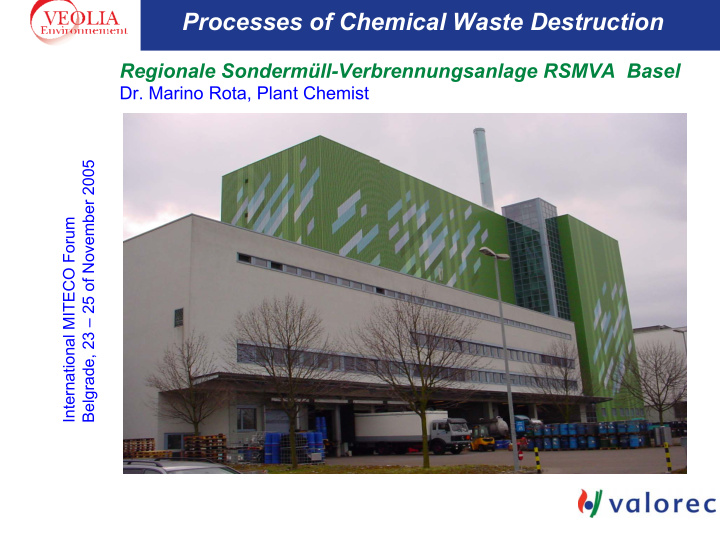



Processes of Chemical Waste Destruction Regionale Sondermüll-Verbrennungsanlage RSMVA Basel Dr. Marino Rota, Plant Chemist Belgrade, 23 – 25 of November 2005 International MITECO Forum
Presentation Overview � History of the Plant � Specific Nature of Chemical Waste � Declaration and Acceptance of Waste � Conditioning of Waste � Technology of HW Incineration Plant � Figures of the Plant RSMVA � Monitoring of Effluents � Conclusions
Chemical Sites in Basel Site St. Site Johann Rosental Site Site Klybeck Schweizerhalle
History of the Plant RSMVA Ciba-Geigy Ciba-Geigy RSMVA First HW Sandoz Novartis Incineration Plant Roche Veolia Env. Local Authorities Dioxin from Seveso !! 1974 1985 1996
Special nature of Chemical Waste Special material Low flash point Ex-safe equipment No storage Reacts with water Infectious waste Exposure of employees Dangerous for environment
Special nature of Chemical Waste � Varying composition of the waste � Often pure compounds � Laboratory waste � high concentration of halogens, sulfur � Reactive products (air / water) � peroxide, metal hydride, acyl halides � Every kind of consistency � solid, liquid, pasty, gaseous
Categories of Chemical Waste � Solid waste: � Filtration Residues (aqueous, organic) � Distillation residues � Obsolete raw materials � Expired medicaments � Laboratory waste (chemicals, equipment) � Pesticides � PCB contaminated capacitors and solids
Categories of Chemical Waste � Liquid waste: � Spent solvents, halogenated and non - halogenated � Mother liquors from chemical production � Concentrated acids contaminated with organics � Obsolete raw materials � PCB contaminated oils
Categories of Chemical Waste � Pasty waste: � Paint residues � Organic Slurry � Gaseous waste: � Freon and Halon gases � Liquefied hydrocarbons (butene) � Gases in pressurized bottles
Declaration of Chemical Waste MSDS Waste producer Waste Declaration EHS Department Card
Declaration of Chemical Waste � Responsibility of waste producer: � EHS department � Creation of a waste declaration card � Characterization of the waste: � Composition, physical and chemical properties of the waste � Definition of HW code � Definition of storage conditions � Definition of protection requirements for employees
Acceptance of Chemical Waste � Technical evaluation by Valorec’s chemist: � Decision about acceptability of waste � Definition of the packaging to the delivery � Definition of internal instructions for the disposal of waste � Check of waste compliance after delivery: � Conditioning of waste � Random sampling and analysis
Conditioning of Chemical Waste � Safe transportation � Safe handling � Reduced emissions SOLIDS � UN approved drums � Metal, plastic, fiber � Size up to 200 L � Cardboard boxes LIQUID � 200 L drums, IBC 1m3 Isotank 20 m3 �
Technology for HW disposal � High Temperature Incineration � State of the art technology applied widely � Large capacity of treatment (3.5 tons/h) � Not sensitive to composition of HW � Recovery of the heat value of HW � Reduction of the amount of HW to less than 15% of weight � Effluents are monitored and environmentally friendly
High Temperature Incineration Requirements for efficient combustion Hazardous Excess Waste Oxygen High Residence Temperature Time
Technology for HW disposal � Combined Heat Recovery Boiler – Steam Turbine � High waste-to-energy yield (> 85%) � Distribution of steam as utility to the chemical production units � Wet flue gas treatment � High removal efficiency for all pollutants due to multi-stage technology (> 99.9%) � Buffer capacity to absorb peaks of pollutants
Small Scale Model of RSMVA Plant
Flow sheet RSMVA Stack Catalyst Turbine NO X Steam 10 bar 220°C Steam 45 bar 350°C ID Fan ca. 40’000 Feed water m3/h Aerosol Post- Solvent combustion (Oil) SO 2 Air SO 2 Heat Recovery Halogen Boiler ca.1200°C 4.0 s Waste Rotary Kiln Dust 1150°C (Oil) 2.5 s 250°C Quench Length : 10 m Air Diameter : 4 m Weight : ca. 180 t Waste water Waste water Treatment Treatment Acidic Alkaline ca. 12 m3/h ca. 8m3/h Slag Ash Rhine/ARA Rhine/ARA Sludge
Annual Capacity of the plant RSMVA � 25’000 tons of HW treated (s, l ,p, g) � Valuable Products � 5’500 MWh of energy produced � 140’000 t of steam � Residues Streams � 1’800 t of slag � 1’000 t of metal hydroxide sludge � 140’000 m3 of treated waste water � 250 Million Nm3 of clean flue gas
Monitoring of Residues Streams � Clean flue gas: � Online in stack for: Dust, HCl, VOC, SO2, NOx, NH3, CO � Discontinuous every 3 years for: Dioxin, Heavy Metals, HF
Emissions RSMVA 2004 100% 50 80 20 5 20 10 50 C o n cen tratio n in % o f th e lim it (acco rd in g to leg islatio n ) 80% 9.0 t/a 60% 0.47 t/a 40% 0.42 t/a 1.77 t/a 20% 0.14 t/a 0.02 t/a 0.02 t/a 0% CO NOX VOC NH3 HCL DUST SO2 Pollutant
Monitoring of Residues Streams � Treated Waste Water: � Online for: Temperature, pH, TOC, Turbidity � Discontinuous: automatic sampling device for storage of daily and monthly samples � Analysis of salts once a month � Analysis of mercury every month � Analysis of other heavy metals every 3 months
Monitoring of Residues Streams � Slag: � Landfill disposal in Switzerland � Assessment of slag quality through leaching test every 3 months � Metal Hydroxide Sludge � Disposal in BigBags in old salt mines (Germany)
Conclusions � The operation of a Chemical Waste Incineration plant in urban area is possible. � The commitment of producer and disposer is essential for an efficient waste disposal. � Safe handling is possible with appropriate conditioning and declaration of the waste. � High temperature incineration is the technology of choice for chemical waste disposal.
Recommend
More recommend